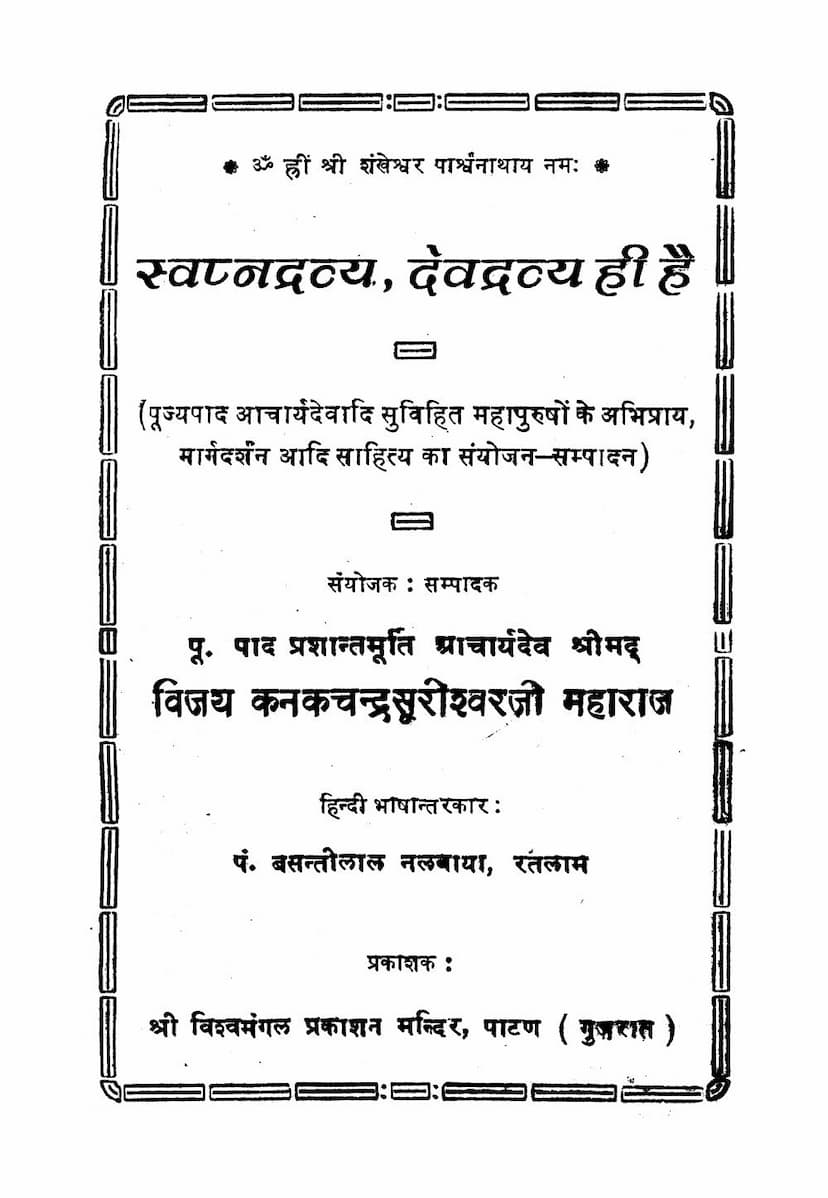Swapnadravya Devdravya Hi Hai
Added to library: September 2, 2025

Summary
This Jain text, "Swapnadravya Devdravya Hi Hai" (Dream-related wealth is indeed Divine wealth), compiled and edited by Acharya Shrimad Vijay Kanakchandrasurishwarji Maharaj and translated into Hindi by Pandit Basantilal Nalwaya, addresses a crucial issue within the Jain community: the proper classification and utilization of Swapnadravya.
The core argument of the book is that the wealth generated from "dream offerings" (Swapnadravya), particularly from the tradition of "dream interpretations" or "dream lotteries" held during the Paryushan festival, is fundamentally Devdravya (Divine wealth). This wealth is meant solely for the maintenance, upkeep, and glorification of temples and religious institutions, and not for general or "ordinary" expenses.
The book presents a strong refutation against the growing practice in some Jain communities to inflate the prices of these dream offerings and transfer the excess amount to the "ordinary account" (Sadharan Khata) to cover general expenses. The authors and the revered Acharyas quoted within the text vehemently oppose this practice, deeming it "unscriptural" (ashastriya) and a transgression against Jain principles.
Key Points and Arguments from the Text:
- Definition of Devdravya: Wealth willingly offered to the Divine for devotional purposes is considered Devdravya. This includes offerings made during various religious ceremonies and events.
- Swapnadravya as Devdravya: The practice of "dream offerings," where devotees bid for the privilege of symbolic dream interpretations, is directly linked to divine auspiciousness. The dreams themselves are seen as auspicious visions experienced by the mother of a Tirthankara, signifying the Tirthankara's impending birth and spiritual glory. Therefore, any wealth derived from this practice is considered inherently divine.
- Unscripturality of Reclassifying Swapnadravya: The book extensively quotes and presents letters and pronouncements from numerous revered Jain Acharyas and scholars across India. These esteemed figures consistently uphold the traditional understanding that Swapnadravya is exclusively Devdravya. They strongly condemn the attempt to divert this wealth to ordinary accounts, arguing that it constitutes a misuse and potential misappropriation of divine funds.
- Consequences of Misusing Devdravya: The text warns that the misuse or destruction of Devdravya leads to severe spiritual repercussions, including the accumulation of great sin and a prolonged cycle of rebirths. Conversely, its proper protection and utilization lead to the accumulation of immense merit and are considered a cause for attaining Tirthankara status.
- Historical Context and Scholarly Consensus: The book highlights that this debate is not new and has been a point of discussion for at least fifty years. However, the overwhelming consensus among learned Acharyas and scriptures points towards the unwavering classification of Swapnadravya as Devdravya. The text cites various ancient Jain texts like "Shraddhavidhi," "Dravya Saptatika," and "Sen Prashna" to support its claims.
- The Role of Munishri Hansvijayji and Acharya Vijay Kanakchandrasurishwarji: The book is a testament to the diligent efforts of Munishri Hansvijayji and, more importantly, Acharya Shrimad Vijay Kanakchandrasurishwarji Maharaj, who, through meticulous compilation and editing, brought forth this crucial guidance. The preface by Muni Shrimad Poornachandravijayji further emphasizes the need for such a publication to counter the "undesirable trend" of misclassifying Devdravya.
- Debunking Misinformation: The book specifically addresses and refutes misinterpretations or false claims attributed to respected past Acharyas, such as Acharya Shrimad Vijayanand (Atmaramji) Maharaj, regarding the use of Swapnadravya for ordinary purposes. It presents evidence from their own writings and teachings to prove their adherence to the traditional classification of this wealth as Devdravya.
- Call to Action for Jain Communities: The book urges Jain communities to understand, accept, and honor the eternal truth about Devdravya by reading and contemplating its contents. It appeals to the Sanghs (religious congregations) to uphold the scriptural tradition and ensure that wealth generated from divine sources is used only for divine purposes.
- Proper Utilization of Devdravya: While emphasizing that Devdravya is solely for divine purposes (like temple construction, renovation, and maintenance), the text also touches upon the proper use of wealth generated from "Guru Puja" (worship of spiritual preceptors). It clarifies that this wealth is also considered Devdravya and should not be diverted to "Vaiyaavritya" (service of ascetics) accounts, but rather utilized for the upkeep of temples or associated religious activities.
- The "Sen Prashna" and "Heer Prashna": These authoritative Jain texts are frequently referenced to support the arguments regarding the sanctity and proper handling of Devdravya, including the concept of interest on Devdravya and its usage.
In essence, "Swapnadravya Devdravya Hi Hai" serves as a comprehensive and authoritative treatise that aims to preserve the purity and sanctity of Jain religious funds by firmly establishing that wealth generated from dream offerings is an inviolable form of Divine wealth, meant exclusively for divine purposes. It acts as a strong corrective against any deviation from scriptural principles and traditions in the handling of such sacred resources.